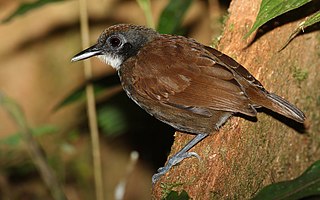
The antbirds are a large passerine bird family, Thamnophilidae, found across subtropical and tropical Central and South America, from Mexico to Argentina. There are more than 230 species, known variously as antshrikes, antwrens, antvireos, fire-eyes, bare-eyes and bushbirds. They are related to the antthrushes and antpittas, the tapaculos, the gnateaters and the ovenbirds. Despite some species' common names, this family is not closely related to the wrens, vireos or shrikes.

The Mato Grosso antbird is a species of bird in subfamily Thamnophilinae of family Thamnophilidae, the "typical antbirds". It is found in Bolivia, Brazil, and Paraguay.
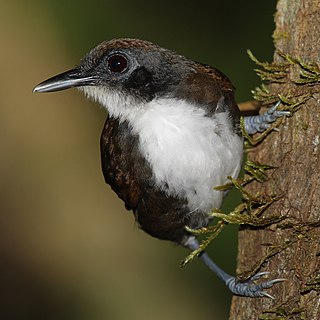
Gymnopithys is a genus of passerine birds in the antbird family, Thamnophilidae.
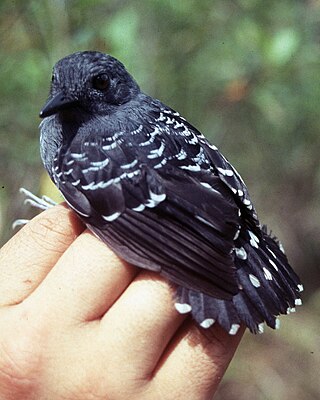
The common scale-backed antbird is a species of passerine bird in subfamily Thamnophilinae of family Thamnophilidae, the "typical antbirds". It is found in Bolivia, Brazil, Colombia, Ecuador, French Guiana, Guyana, Peru, Suriname, and Venezuela.

Goeldi's antbird is a species of bird in subfamily Thamnophilinae of family Thamnophilidae, the "typical antbirds". It is found in Bolivia, Brazil and Peru.
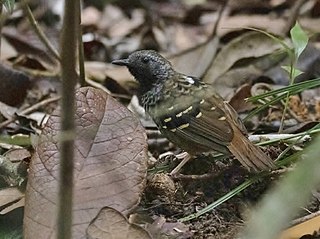
The scalloped antbird is an Endangered species of passerine bird in subfamily Thamnophilinae of family Thamnophilidae, the "typical antbirds". It is endemic to Brazil.

The ocellated antbird is a species of antbird in subfamily Thamnophilinae of family Thamnophilidae, the "typical antbirds". It is found in Colombia, Costa Rica, Ecuador, Honduras, Nicaragua, and Panama.
The Argus bare-eye is a species of bird in the family Thamnophilidae. Known only from a single male specimen taken in 1951 in Colombia, its taxonomic validity is questionable, and most authorities do not recognize it, following Willis (1979) and Graves (1992), where it was shown to be a hybrid between the black-spotted and the reddish-winged bare-eye.

The reddish-winged bare-eye is a species of insectivorous passerine bird in subfamily Thamnophilinae of family Thamnophilidae, the "typical antbirds". It is found in Bolivia, Brazil, Colombia, Ecuador, Peru, and Venezuela.

The black-spotted bare-eye is a species of insectivore passerine bird in subfamily Thamnophilinae of family Thamnophilidae, the "typical antbirds". It is found in Bolivia, Brazil, Colombia, Ecuador, and Peru.

The fire-eyes, Pyriglena, are a genus of birds in the antbird family Thamnophilidae.The genus contains 5 species, all found in South America. The fire-eyes are 16–18 cm in length, weigh 25-36 g and have characteristic red eyes that give them their name. They have sexually dimorphic plumage, with the females possessing brown to buff coloured bodies with black tails, and the males being black with small patches of white on the back or wings. The fire-eyes eat a variety of insects, and will regularly follow army ants in order to catch prey flushed by them. Two of the fire-eyes are widespread and safe, but one species, the fringe-backed fire-eye, is threatened with extinction.
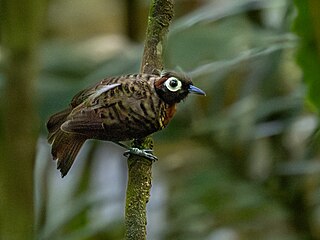
The harlequin antbird is a species of bird in subfamily Thamnophilinae of family Thamnophilidae, the "typical antbirds". It is endemic to Brazil.

Rhegmatorhina is a genus of insectivorous passerine birds in the antbird family, Thamnophilidae.
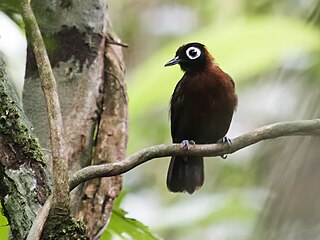
The chestnut-crested antbird is a species of bird in subfamily Thamnophilinae of family Thamnophilidae, the "typical antbirds". It is found in Brazil and Colombia.

The bare-eyed antbird, occasionally known as the Santarem antbird, is a Vulnerable species of insectivorous passerine bird in subfamily Thamnophilinae of family Thamnophilidae, the "typical antbirds". It is endemic to Brazil.

The white-breasted antbird is a species of bird in subfamily Thamnophilinae of family Thamnophilidae, the "typical antbirds". It is endemic to Brazil.

Myrmelastes is a genus of passerine birds in the family Thamnophilidae. Most of these species were previously placed in the genus Schistocichla. The genus formerly included only three species, but several taxa previously considered subspecies of the spot-winged antbird have been elevated to species status.
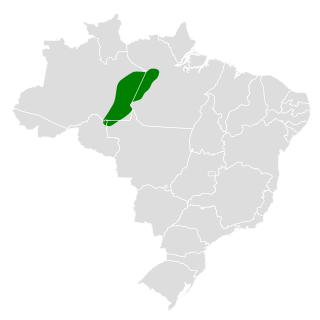
The pale-faced bare-eye, sometimes known as the pale-faced antbird, is a species of bird in subfamily Thamnophilinae of family Thamnophilidae, the "typical antbirds". It is endemic to Brazil.

Edwin O'Neill Willis was an American ornithologist who studied the birds of Central and South America.



















